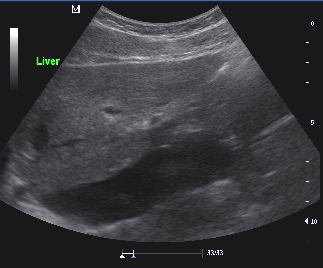Abdominal Ultrasound
Ultrasound imaging is particularly valuable in the examination of the organs of the abdomen and is often used as a first line of investigation in a wide variety of clinical conditions, including:
- General Abdominal Pain or flank pain.
- Suspected Gall Stones
- Urinary problems
- Abdominal swelling
- Bloating
- Liver problems
Abdominal ultrasound is extremely good at visualising the main abdominal organs and may be used to assess their size, shape and internal structure. It enables an experience Sonographer/Radiologist to detect solid or cystic masses; including malignant and benign tumours, abscesses, fluid collection and inflammation within the abdomen, as well as stones in the Kidneys, Ureters and Gall Bladder.
The Sonographer can also visualise and measure the abdominal aorta (the main blood vessel leading from the heart) to detect the presence of an aortic aneurysm. Calculi (stones) of the gallbladder, kidneys, and ureters may be detected by ultrasound.
- Abdominal Aortic Aneurysm
Another extremely important reason for Abdominal Ultrasound is in the investigation of suspect Abdominal Aortic Aneurysm.
The abdominal aorta is a large artery that supplies blood throughout the abdomen, pelvis and legs. Sometimes an area of the aortic wall weakens, most commonly due to atherosclerotic disease, resulting in a widening or ballooning of the blood vessel. As the Aorta swells, the chance of it rupturing becomes increasingly great. A ruptured aneurysm is a true surgical emergency with poor survival rates, however if identified early treatment can be managed, greatly increasing survival rates.
Anyone can develop an abdominal aortic aneurysm, but it is most frequently seen in 60+ year old males, particularly smokers or those with high blood pressure, high cholesterol level, emphysema or a hereditary risk.
The classic indication of an abdominal aortic aneurysm is a pulsatile mass in the abdomen, and Ultrasound can be used to investigate such signs or be used as a screening tool for those with out symptoms.
What preparation is required for the an Abdominal Ultrasound scan?
In general, any examination of your upper abdomen will require you to refrain from eating or drinking for a few hours prior to your appointment. This will allow us to better visualise the Gall Bladder and Biliary tract. If the Doctor is particularly interested in your Kindeys, then we may ask you to drink a pint of water in the hour before your examination, so that you attend with a full bladder. If the examination is limited to looking for an Aortic Aneurysm, then no preparation is required.
What will happen during the examination?
The procedure is non-invasive and painless. You will be asked to lie on your back on the examination couch and expose your abdomen. Our highly qualified and experienced Sonographer will move a transducer lubricated with warm gel over your abdomen to obtain the necessary images. You are welcome to ask questions during your examination. You may bring someone into the examination room with you if you wish (no children please), and a HealthCare Assistant will also be on hand should you require support or a chaperone.
Click here for more information on different types of Ultrasound Scans



